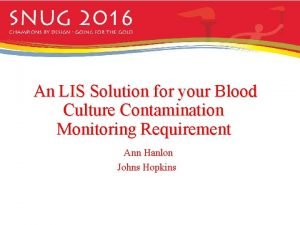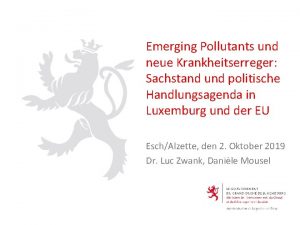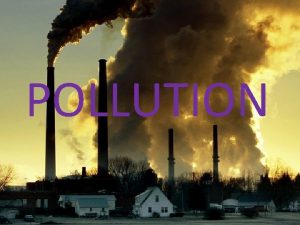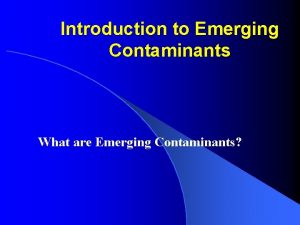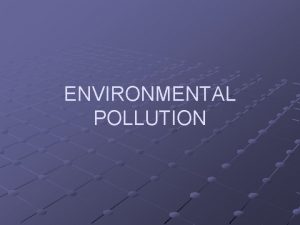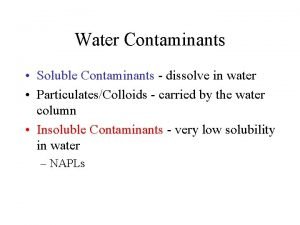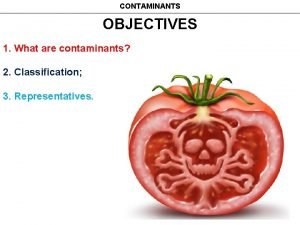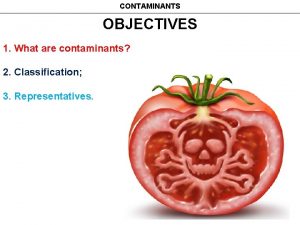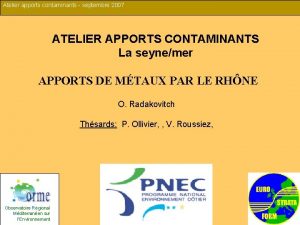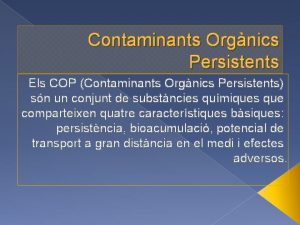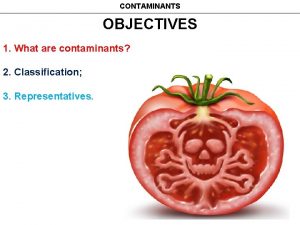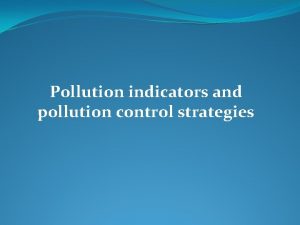POLLUTION Pollution is the introduction of contaminants into

















- Slides: 17

POLLUTION Pollution is the introduction of contaminants into a natural environment that causes instability, disorder, harm or discomfort to the ecosystem i. e. physical systems or living organisms.

TYPES OF AIR POLLUTION § § Air pollution Noise pollution Land pollution Water pollution

AIR POLLUTION �Air pollution is the introduction of chemicals, particulate matter, or biological materials that cause harm or discomfort to humans or other living organisms, or cause damage to the natural environment or built environment, into the atmosphere.

SOURCES OF AIR POLLUTION �Household combustion devices. • � Motor vehicles. �Industrial facilities. � • Forest fires

Pollutants causing Air Pollution • Include particulate matter. • Carbon monoxide. • Ozone. • Nitrogen dioxide. • Sulfur dioxide

How to control air pollution? • Maintaining a healthy distance between the industrial and residential areas. • The chimneys should be constructed tall insize so that the emissions must be released higher up in the environment • The sulphur must be removed after burning. • The gasoline must have anti knock ingagents. . • The mining area should be planted with trees.

NOISE POLLUTION �Noise pollution is excessive, displeasing human, animal or machine-created environmental noise that disrupts the activity or balance of human or animal life. The word noise comes from the Latin word nauseas , meaning seasickness.

Sources of Noise Pollution • Machines. • Transportation systems. • Motor vehicles. • Aircrafts. • Trains. • Poor urban planning.

LAND POLLUTION �Land pollution is the degradation of Earth's land surfaces often caused by human activities and their misuse of land resources

Causes of Land Pollution � 1. Deforestation and soil erosion � 2. Agricultural activities � 3. Mining activities � 4. Overcrowded landfills � 5. Industrialization � 6. Construction activities � 7. Nuclear waste � 8. Sewage treatment

Effects of Land Pollution � 1. Soil pollution � 2. Change in climate patterns � 3. Environmental Impact � 4. Effect on human health � 5. Cause Air pollution � 6. Distraction for Tourist � 7. Effect on wildlife

Solutions for Land Pollution � 1. Make people aware about the concept of Reduce, Recycle and Reuse. � 2. Reduce the use of pesticides and fertilizers in agricultural activities. � 3. Avoid buying packages items as they will lead to garbage and end up in landfill site. � 4. Ensure that you do not litter on the ground and do proper disposal of garbage. � 5. Buy biodegradable products. � 6. Do Organic gardening and eat organic food that will be grown without the use of pesticides. � 7. Create dumping ground away from �residential areas.

Effects of Noise Pollution Noise pollution affects both health and behavior. • Unwanted sound (noise) can damage psychological health. • Noise pollution cause • Annoyance • Aggression. • Hypertension. • High stress levels. • Hearing loss. • sleep disturbances, and other harmful effects.

WATER POLLUTION �Water pollution is the contamination of water bodies (e. g. lakes, rivers, oceans and groundwater). Water pollution occurs when pollutants are discharged directly or indirectly into water bodies without adequate treatment to remove harmful compounds.

Water Pollutants • Petroleum hydrocarbons • Plastics • Pesticides • Heavy metals • Sewage • Radioactive waste • Thermal effluents • Detergents • Chloroform • Food processing waste, (fats and grease) • Insecticides and herbicides. • Petroleum hydrocarbons, (gasoline, diesel fuel, jet fuels, and fuel oil). • Lubricants (motor oil). • From stormwater runoff

Preventing Water Pollution • Conserve water by turning off the tap. • Mind what you throw down your sink or toilet. • Don’t throw paints and oils in water channels. • Use environment friendly household products, such as washing powder, household cleaning agents etc. • Take great care not to overuse pesticides and fertilizers. • Don’t throw litter into rivers, lakes or oceans. Help clean up any litter you see on beaches or in rivers and lakes, make sure it is safe to collect the litter and put it in a nearby dustbin

POLLUTION PREVENTION �Pollution prevention reduces the amount of pollution generated by a process, whether it is consumer. In contrast to most pollution control strategies, which seek to manage a after it is formed and reduce its impact upon the environment the pollution prevention approach seeks to increase the efficiency of a process, thereby reducing the amount of pollution generated at its source. Although there is wide agreement that source reduction is the preferred strategy
 Common blood culture contaminants
Common blood culture contaminants Grundwasserreinigung emerging contaminants
Grundwasserreinigung emerging contaminants Hình ảnh bộ gõ cơ thể búng tay
Hình ảnh bộ gõ cơ thể búng tay Frameset trong html5
Frameset trong html5 Bổ thể
Bổ thể Tỉ lệ cơ thể trẻ em
Tỉ lệ cơ thể trẻ em Gấu đi như thế nào
Gấu đi như thế nào Chụp phim tư thế worms-breton
Chụp phim tư thế worms-breton Bài hát chúa yêu trần thế alleluia
Bài hát chúa yêu trần thế alleluia Kể tên các môn thể thao
Kể tên các môn thể thao Thế nào là hệ số cao nhất
Thế nào là hệ số cao nhất Các châu lục và đại dương trên thế giới
Các châu lục và đại dương trên thế giới Công thức tính độ biến thiên đông lượng
Công thức tính độ biến thiên đông lượng Trời xanh đây là của chúng ta thể thơ
Trời xanh đây là của chúng ta thể thơ Mật thư anh em như thể tay chân
Mật thư anh em như thể tay chân Làm thế nào để 102-1=99
Làm thế nào để 102-1=99 độ dài liên kết
độ dài liên kết Các châu lục và đại dương trên thế giới
Các châu lục và đại dương trên thế giới
